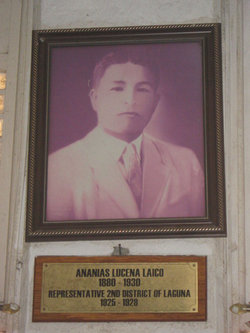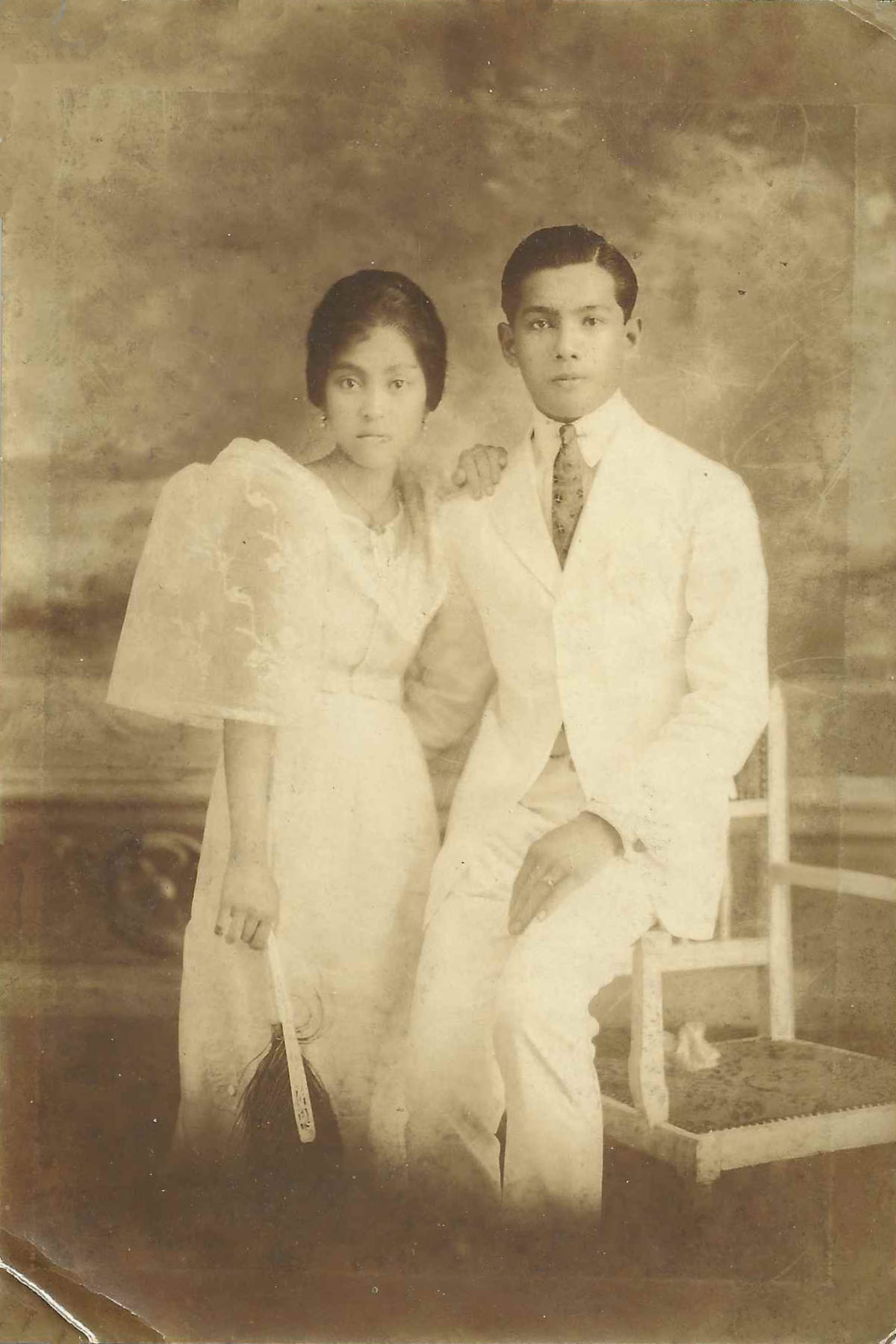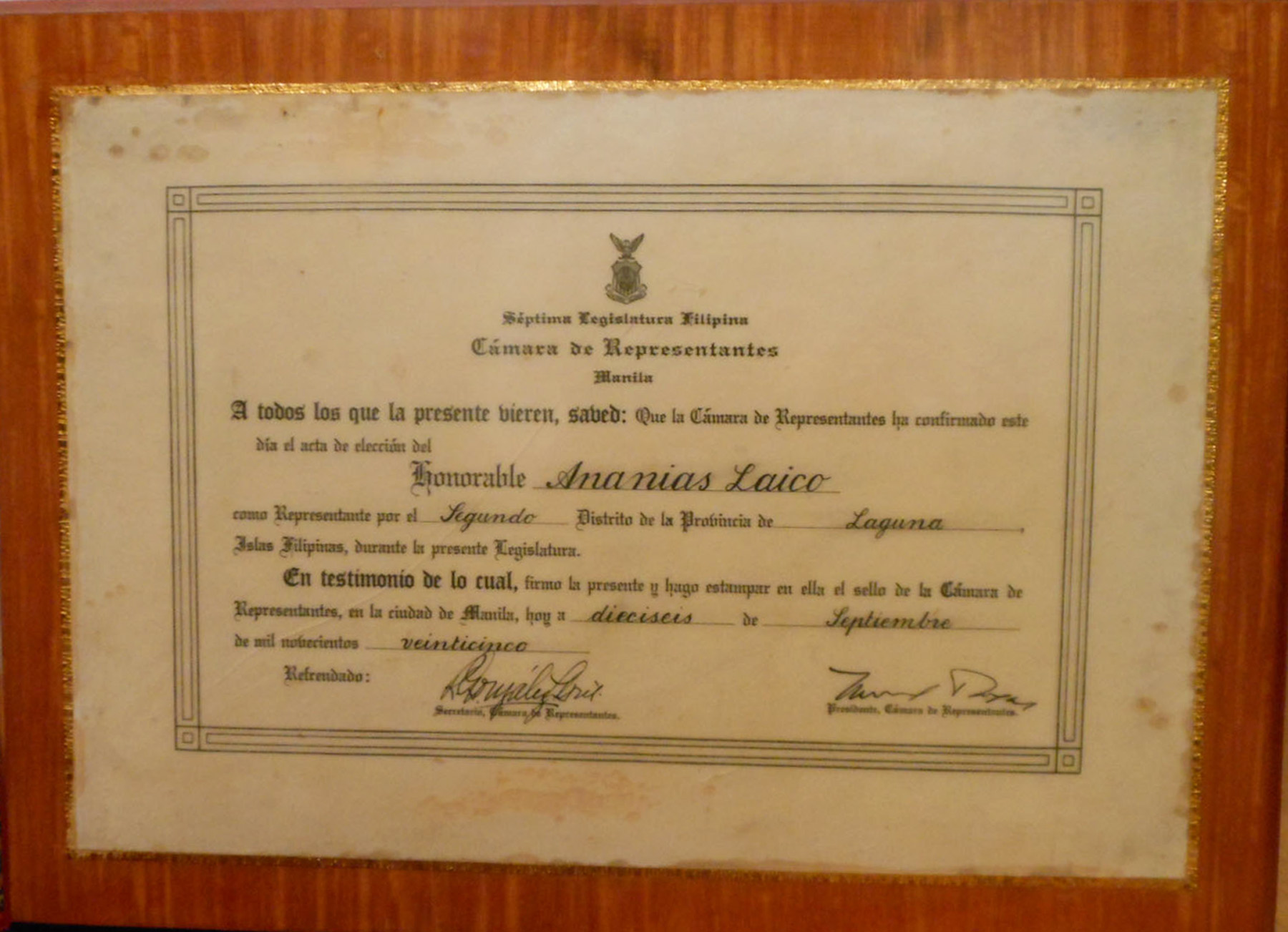Background
Ananias was born on 24 January 1877 in Magdalena, Laguna, Philippines, the fourth child of Don Luis Ong-Layco by his second wife, Doña Maria Concepcion Bernardo Lucena. He was baptised at the Santa Maria Magdalena Catholic Church in Magdalena three days later, on January 27. His father Luis was from Pagsanjan, Laguna. According to tradition, the Laico family originally came from Xiamen (formerly known as Amoy), Fujian Province, China, although the Ong-Layco surname or variants have appeared in Laguna parish records since at least the late eighteenth century.
Ananias Laico was thus a Chinese-Filipino mestizo, part of a community who have played (and continue to play) an important role in Philippine affairs.
Family
Ananias married Maria Rosario San Carlos Evidente, the daughter of Don Roman Bernardo Evidente and Doña Roberta Rato San Carlos of Magdalena, on 11 April 1899 at the Santa Maria Magdalena Catholic Church in Magdalena. The Evidente family was one of the most prominent families in the area; Rosario's first cousin Maximo Evidente was presidente municipal (mayor) of Magdalena. Ananias and Rosario were third cousins - they shared the same great-grandparents, Juan Pascual Bernardo and Vicenta De la Rosa (Ananias: his mother's mother's parents; Rosario: her father's mother's parents).
Ananias and Rosario Laico had 10 children, in the following order: Emilio (born probably 1900 or 1901), Maria Natividad (b. 1902), Jaime (b. 1903), Laura (b. 1905), Beatriz (b. 1907), Luz (b. 1908), Luis (b. 1910), Lydia (b. 1912), Cesar (b. 1914) and Ester (b. 1916).
Professional Life
Ananias Laico studied at the Ateneo de Manila and obtained a Bachelor of Arts.
The Laico family business was copra (coconut) farming, and the Laicos were major landowners in Magdalena. Some of Ananias' properties still belong to his descendants. Copra was the principal crop in Laguna and brought considerable prosperity to the province in the early twentieth century. However, he was much more than a haciendero.
Ananias served in the Filipino army during the struggle for independence in the late 1890s. He became a deputy of police for Magdalena and also a teacher - he is listed as a teacher, third grade, at the Central School in Magdalena in 1906. (The record for the school includes only 2 teachers, Ananias and his American supervisor.) Later, he was the school principal.
Ananias Laico's ambition then turned to law. He was admitted to the Philippine Bar on 12 October 1912 and practiced as a lawyer and notary (notario publico) in Magdalena. The registers (registros notariales) that he compiled have survived and are held in the Archives of the National Library in Manila.
Ananias' name appears as one of 3 members of the Municipal Advisory Census Board for Magdalena when the Philippine Census was conducted in 1918.
Ananias Laico was elected as an Assemblyman to the Philippine House of Representatives in June 1925, representing the Second District of Laguna. He ran for the Consolidado faction of the ruling Nacionalista Party. In the election, Ananias narrowly won over the incumbent assemblyman, Aurelio Palileo, 4913 votes to 4565. Ananias served during the Seventh Philippine Legislature, which officially was in session between July 1925 and November 1927. From this position, he earned the title 'Honorable.' Ananias ran in the next election, in 1928, but lost to Arsenio Bonifacio.
Records indicate that Ananias Laico and his older brother Francisco attended the First Independence Congress held in Manila in February 1930.
In the 1930s, Ananias Laico served as the provincial sheriff of Laguna. One of his cases, Jose H. Guevarra v. Ananias Laico, et al., reached the Supreme Court of the Philippines in 1937 and became a legal precedent used by lawyers in the Philippines. It involved the eviction of a tenant by a landlord.
Death
Ananias Laico died on 9 January 1939 in Magdalena, a few weeks before his 62nd birthday. The cause of death was nephritis acidosis, though he also suffered from hypertension. His funeral took place at the Santa Maria Magdalena Catholic Church in Magdalena on January 12. His wife Rosario survived him; she died on 14 July 1952. Ananias was originally buried in the Catholic Parish Cemetery in Magdalena, however his remains (along with his wife's) were later transferred to the Manila South Cemetery.
Family stories
A number of stories about Ananias Laico have been passed down, principally though his youngest daughter Ester, who also inherited properties, several pieces of fine furniture, photos, diplomas, etc. from her parents.
Entry into Politics - On one occasion, Ananias traveled by train from Magdalena to Manila with the intention of buying properties - and ended up doing something completely different. While on the trip, he met a friend who persuaded him to enter politics.
Fortune-teller - Ananias Laico was known as a sort of fortune-teller. In one instance, someone came to him about a lost object and Ananias was able to correctly tell him where to find it.
Monkeys - Ananias and Rosario kept several monkeys (matsing) as pets in their house in Magdalena. Someone warned Ananias that these monkeys would bring him bad luck. Ananias died early and so people believed that this prediction came true.
Legacy
In 1957, the Philippine Congress passed an Act changing the name of the Magdalena Elementary School to the Ananias Laico Memorial Elementary School.
Of Ananias and Rosario's children, Jaime became a pioneering plastic surgeon in the Philippines and the author of many medical papers published there as well as in the United States.
Principal Sources
Census of the Philippine Islands taken under the direction of the Philippine Legislature in the year 1918, Appendix to Volume I (1920)
election leaflet for Ananias Laico (1925, surviving portion)
FamilySearch. "Registros parroquiales, 1821-1968 - Catholic Church. Santa María Magdalena (Magdalena, Laguna)," digitized images database
Genealogy of Juan Pascual Bernardo (1977)
Laguna in American Times: Coconuts and Revolutionarios (1981)
The LAWPHIL Project website (http://lawphil.net/judjuris/juri1937/feb1937/gr_l-44057_1937.html), accessed November 2014
Official Roster of the Bureau of Education, corrected to March 1, 1906 (1906)
Proceedings of the First Independence Congress: Held in the City of Manila, Philippine Islands, February 22-26, 1930 (1930)
Background
Ananias was born on 24 January 1877 in Magdalena, Laguna, Philippines, the fourth child of Don Luis Ong-Layco by his second wife, Doña Maria Concepcion Bernardo Lucena. He was baptised at the Santa Maria Magdalena Catholic Church in Magdalena three days later, on January 27. His father Luis was from Pagsanjan, Laguna. According to tradition, the Laico family originally came from Xiamen (formerly known as Amoy), Fujian Province, China, although the Ong-Layco surname or variants have appeared in Laguna parish records since at least the late eighteenth century.
Ananias Laico was thus a Chinese-Filipino mestizo, part of a community who have played (and continue to play) an important role in Philippine affairs.
Family
Ananias married Maria Rosario San Carlos Evidente, the daughter of Don Roman Bernardo Evidente and Doña Roberta Rato San Carlos of Magdalena, on 11 April 1899 at the Santa Maria Magdalena Catholic Church in Magdalena. The Evidente family was one of the most prominent families in the area; Rosario's first cousin Maximo Evidente was presidente municipal (mayor) of Magdalena. Ananias and Rosario were third cousins - they shared the same great-grandparents, Juan Pascual Bernardo and Vicenta De la Rosa (Ananias: his mother's mother's parents; Rosario: her father's mother's parents).
Ananias and Rosario Laico had 10 children, in the following order: Emilio (born probably 1900 or 1901), Maria Natividad (b. 1902), Jaime (b. 1903), Laura (b. 1905), Beatriz (b. 1907), Luz (b. 1908), Luis (b. 1910), Lydia (b. 1912), Cesar (b. 1914) and Ester (b. 1916).
Professional Life
Ananias Laico studied at the Ateneo de Manila and obtained a Bachelor of Arts.
The Laico family business was copra (coconut) farming, and the Laicos were major landowners in Magdalena. Some of Ananias' properties still belong to his descendants. Copra was the principal crop in Laguna and brought considerable prosperity to the province in the early twentieth century. However, he was much more than a haciendero.
Ananias served in the Filipino army during the struggle for independence in the late 1890s. He became a deputy of police for Magdalena and also a teacher - he is listed as a teacher, third grade, at the Central School in Magdalena in 1906. (The record for the school includes only 2 teachers, Ananias and his American supervisor.) Later, he was the school principal.
Ananias Laico's ambition then turned to law. He was admitted to the Philippine Bar on 12 October 1912 and practiced as a lawyer and notary (notario publico) in Magdalena. The registers (registros notariales) that he compiled have survived and are held in the Archives of the National Library in Manila.
Ananias' name appears as one of 3 members of the Municipal Advisory Census Board for Magdalena when the Philippine Census was conducted in 1918.
Ananias Laico was elected as an Assemblyman to the Philippine House of Representatives in June 1925, representing the Second District of Laguna. He ran for the Consolidado faction of the ruling Nacionalista Party. In the election, Ananias narrowly won over the incumbent assemblyman, Aurelio Palileo, 4913 votes to 4565. Ananias served during the Seventh Philippine Legislature, which officially was in session between July 1925 and November 1927. From this position, he earned the title 'Honorable.' Ananias ran in the next election, in 1928, but lost to Arsenio Bonifacio.
Records indicate that Ananias Laico and his older brother Francisco attended the First Independence Congress held in Manila in February 1930.
In the 1930s, Ananias Laico served as the provincial sheriff of Laguna. One of his cases, Jose H. Guevarra v. Ananias Laico, et al., reached the Supreme Court of the Philippines in 1937 and became a legal precedent used by lawyers in the Philippines. It involved the eviction of a tenant by a landlord.
Death
Ananias Laico died on 9 January 1939 in Magdalena, a few weeks before his 62nd birthday. The cause of death was nephritis acidosis, though he also suffered from hypertension. His funeral took place at the Santa Maria Magdalena Catholic Church in Magdalena on January 12. His wife Rosario survived him; she died on 14 July 1952. Ananias was originally buried in the Catholic Parish Cemetery in Magdalena, however his remains (along with his wife's) were later transferred to the Manila South Cemetery.
Family stories
A number of stories about Ananias Laico have been passed down, principally though his youngest daughter Ester, who also inherited properties, several pieces of fine furniture, photos, diplomas, etc. from her parents.
Entry into Politics - On one occasion, Ananias traveled by train from Magdalena to Manila with the intention of buying properties - and ended up doing something completely different. While on the trip, he met a friend who persuaded him to enter politics.
Fortune-teller - Ananias Laico was known as a sort of fortune-teller. In one instance, someone came to him about a lost object and Ananias was able to correctly tell him where to find it.
Monkeys - Ananias and Rosario kept several monkeys (matsing) as pets in their house in Magdalena. Someone warned Ananias that these monkeys would bring him bad luck. Ananias died early and so people believed that this prediction came true.
Legacy
In 1957, the Philippine Congress passed an Act changing the name of the Magdalena Elementary School to the Ananias Laico Memorial Elementary School.
Of Ananias and Rosario's children, Jaime became a pioneering plastic surgeon in the Philippines and the author of many medical papers published there as well as in the United States.
Principal Sources
Census of the Philippine Islands taken under the direction of the Philippine Legislature in the year 1918, Appendix to Volume I (1920)
election leaflet for Ananias Laico (1925, surviving portion)
FamilySearch. "Registros parroquiales, 1821-1968 - Catholic Church. Santa María Magdalena (Magdalena, Laguna)," digitized images database
Genealogy of Juan Pascual Bernardo (1977)
Laguna in American Times: Coconuts and Revolutionarios (1981)
The LAWPHIL Project website (http://lawphil.net/judjuris/juri1937/feb1937/gr_l-44057_1937.html), accessed November 2014
Official Roster of the Bureau of Education, corrected to March 1, 1906 (1906)
Proceedings of the First Independence Congress: Held in the City of Manila, Philippine Islands, February 22-26, 1930 (1930)
Family Members
Sponsored by Ancestry
Advertisement
Advertisement








